1996 CHEVROLET TAHOE stop start
[x] Cancel search: stop startPage 154 of 403
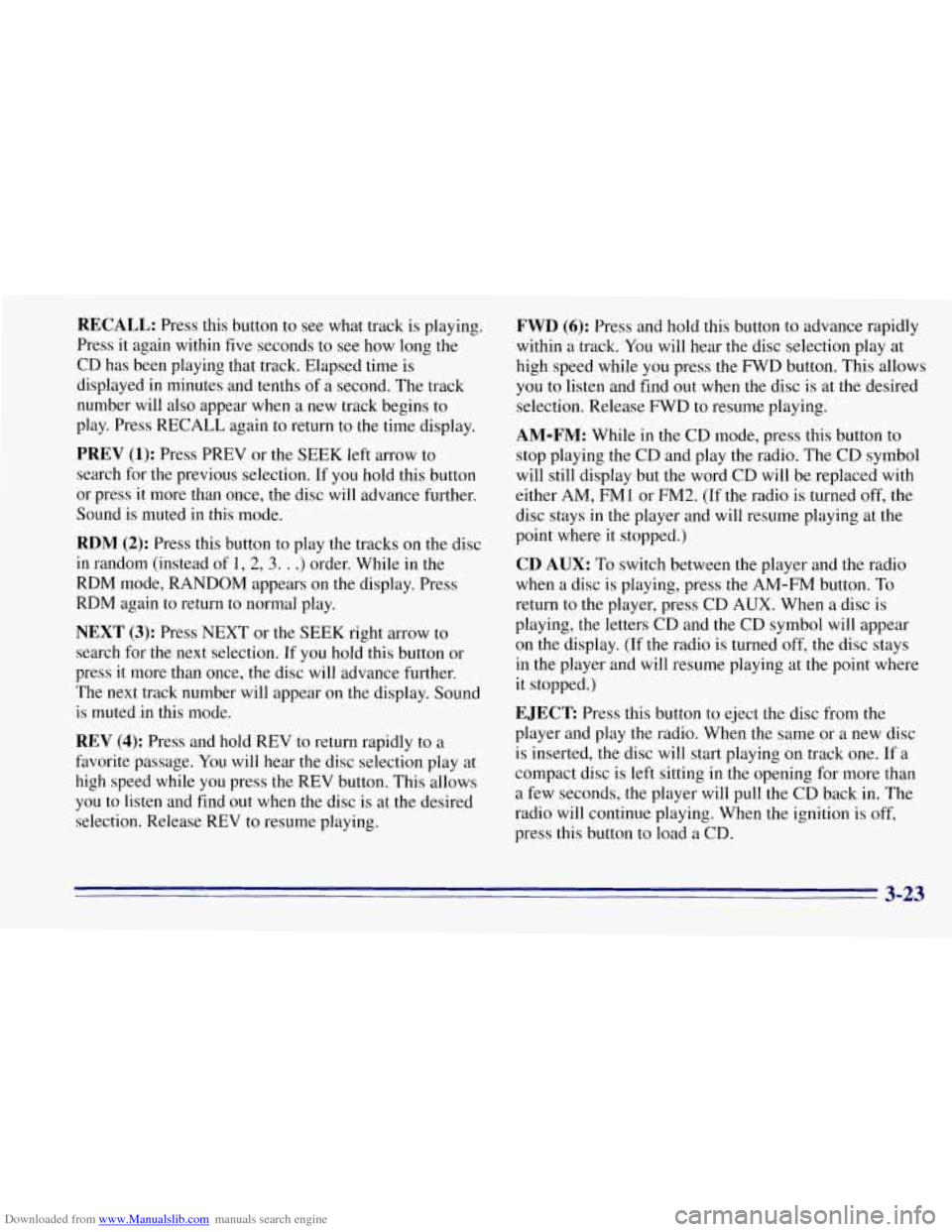
Downloaded from www.Manualslib.com manuals search engine RECALL: Press this button to see what track is playing.
Press it again within five seconds to see how long the
CD has been playing that track. Elapsed time is
displayed in minutes and tenths of a second. The track
number will also appear when a new track begins to
play. Press RECALL again to return to the time display.
PREV (1): Press PREV or the SEEK left arrow to
search for the previous selection. If you hold this button
or press it more than once, the disc will advance further.
Sound is muted in this mode.
RDM (2): Press this button to play the tracks on the disc
in random (instead of
1, 2, 3. . .) order. While in the
RDM mode, RANDOM appears on the display. Press
RDM again to return to normal play.
NEXT (3): Press NEXT or the SEEK right arrow to
search for the next selection.
If you hold this button or
press it more than once, the disc will advance further.
The next track number will appear on the display. Sound
is muted in this mode.
REV (4): Press and hold REV to return rapidly to a
favorite passage. You will hear the disc selection play at
high speed while you press the REV button. This allows
you to listen and find out when the disc is at the desired
selection. Release REV
to resume playing.
FWD (6): Press and hold this button to advance rapidly
within a track. You will hear the disc selection play at
high speed while you press the FWD button. This allows
you to listen and find out when the disc is at the desired
selection. Release FWD to resume playing.
AM-FM: While in the CD mode, press this button to
stop playing the CD and play the radio. The CD symbol
will still display but the word CD will
be replaced with
either
AM, FMl or FM2. (If the radio is turned off, the
disc stays in the player and will resume playing at the
point where
it stopped.)
CD AUX: To switch between the player and the radio
when a disc is playing, press the AM-FM button.
To
return to the player, press CD AUX. When a disc is
playing, the letters CD and the CD symbol will appear
on the display. (If the radio is turned off, the disc stays
in the player and will resume playing at the point where
it stopped.)
EJECT: Press this button to eject the disc from the
player and play the radio. When the same or a new disc
is inserted, the disc will start playing on track one. If a
compact disc is left sitting in the opening for more than
a few seconds, the player will pull the CD back in. The
radio will continue playing. When the ignition
is off,
press this button to load a CD.
3-23
Page 165 of 403
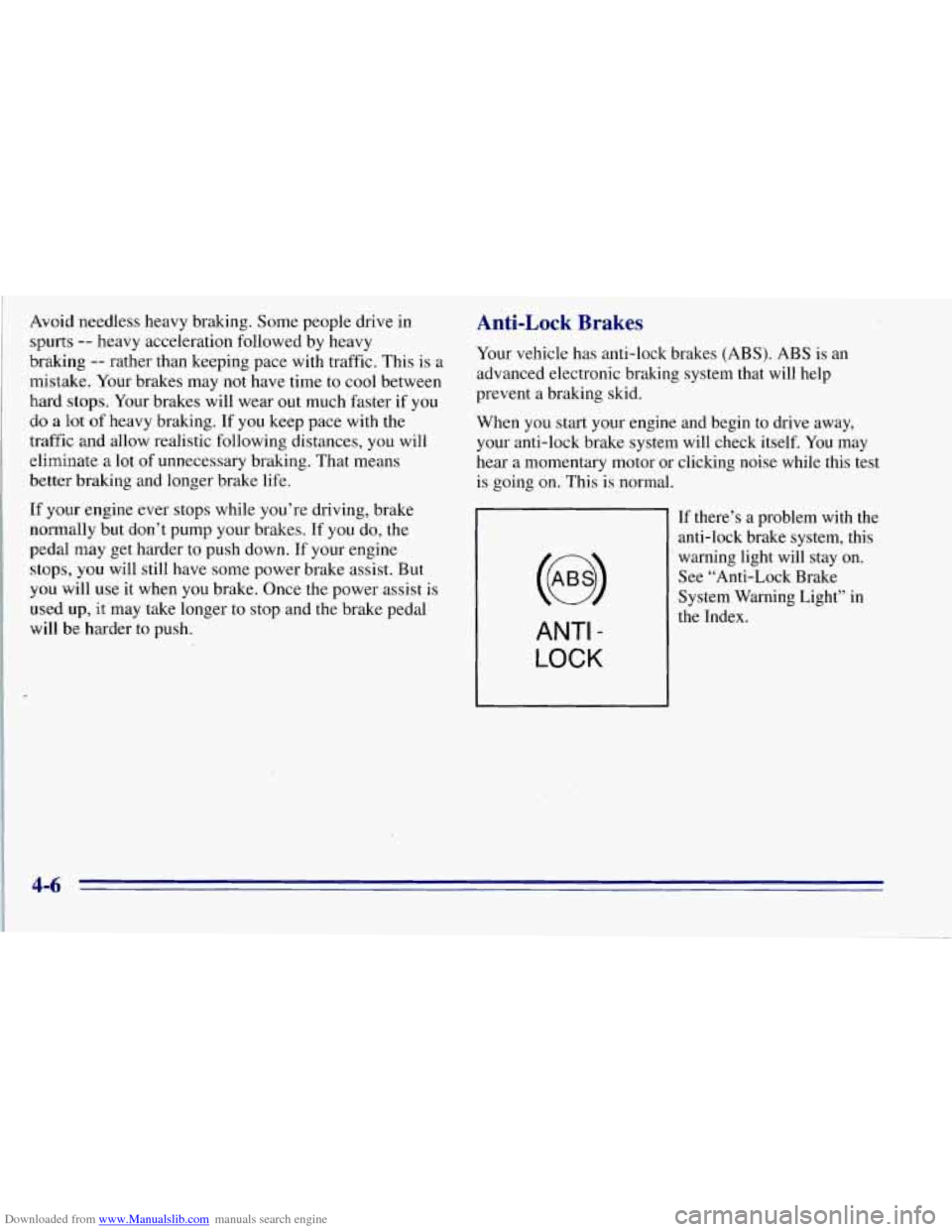
Downloaded from www.Manualslib.com manuals search engine Avoid needless heavy braking. Some people drive in
spurts
-- heavy acceleration followed by heavy
braking
-- rather than keeping pace with traffic. This is a
mistake. Your brakes may not have time
to cool between
hard stops. Your brakes will wear out much faster if you
do a lot of heavy braking. If you keep pace with the
traffic and allow realistic following distances,
you will
eliminate a lot of unnecessary braking. That means
better braking and longer brake life.
Ilf your engine ever stops while you’re driving, brake
normally but don’t pump your brakes. If you do, the
pedal may get harder
to push down. If your engine
sto’ps,
you will still have some power brake assist. But
you will use it when you brake. Once the power assist is
used
up, it‘may take longer to stop and the brake pedal
will be harder to push.
Anti-Lock Brakes
Your vehicle has anti-lock brakes (ABS). ABS is an
advanced electronic braking system that will help
prevent a braking skid.
When you start your engine and begin to drive away,
your anti-lock brake system will check itself.
You may
hear a momentary motor or clicking noise while this test
is going on. This
is normal.
ANTI -
LOCK
If there’s a problem with the
anti-lock brake system, this
warning light will stay on.
See “Anti-Lock Brake
System Warning Light” in
the Index.
4-6
Page 170 of 403
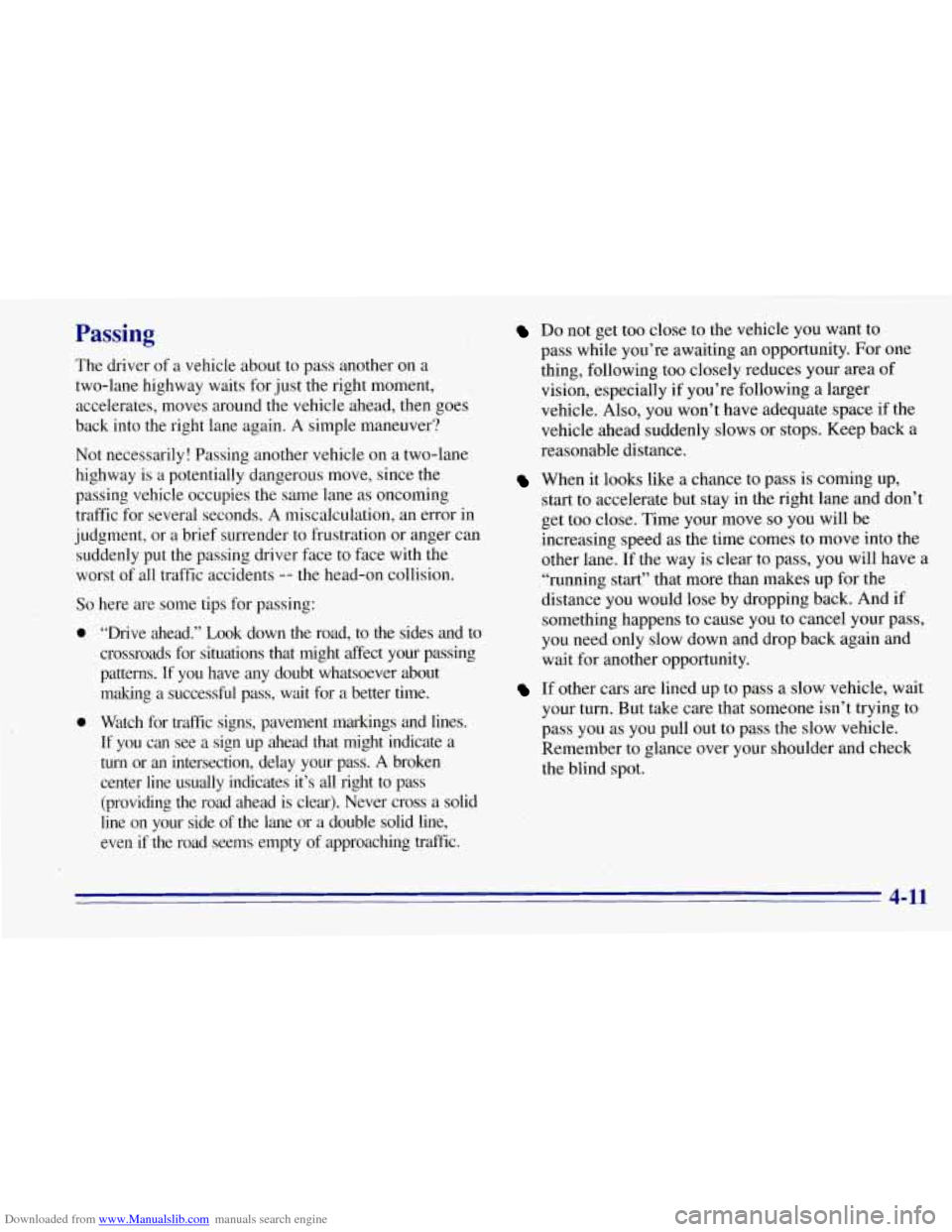
Downloaded from www.Manualslib.com manuals search engine Passing
The driver of a vehicle about to pass another on a
two-lane highway waits for just the right moment,
accelerates, moves around the vehicle ahead, then goes
back into the right lane again.
A simple maneuver?
Not necessarily! Passing another vehicle on a two-lane
highway is a potentially dangerous move, since the
passing vehicle occupies the same lane as oncoming
traffic for several seconds. A miscalculation, an error in
judgment, or a brief surrender
to frustration or anger can
suddenly put the passing driver face to face with the
worst of all traffic accidents
-- the head-on collision.
So here are some tips for passing:
0 “Drive ahead.” Look down the road, to the sides and to
crossroads for situations that might affect your passing
patterns. If you have any doubt whatsoever about
making a successful pass,
wait for a better time.
0 Watch for traffic signs, pavement markings and lines.
If you can see a sign up ahead that might indicate a
turn or
an intersection, delay your pass. A broken
center line usually indicates it’s all right
to pass
(providing the road ahead is clear). Never cross a solid
line
on your side of the lane or a double solid line,
even if the road seems empty of approaching traffic.
Do not get too close to the vehicle you want to
pass while you’re awaiting an opportunity. For one
thing, following too closely reduces your area of
vision, especially if you’re following a larger
vehicle. Also, you won’t have adequate space if the
vehicle ahead suddenly slows or stops. Keep back a
reasonable distance.
When it looks like a chance to pass is coming up,
start to accelerate but stay in the right lane and don’t
get too close. Time your move
so you will be
increasing speed as the time comes to move into the
other lane. If the way
is clear to pass, you will have a
“running start” that more than makes up for the
distance you would lose by dropping back. And if
something happens
to cause you to cancel your pass,
you need only slow down and drop back again and
wait for another opportunity.
If other cars are lined up to pass a slow vehicle, wait
your turn. But take care that someone isn’t trying to
pass you as you pull out to pass the slow vehicle.
Remember to glance over your shoulder and check
the blind spot.
4-11
Page 172 of 403
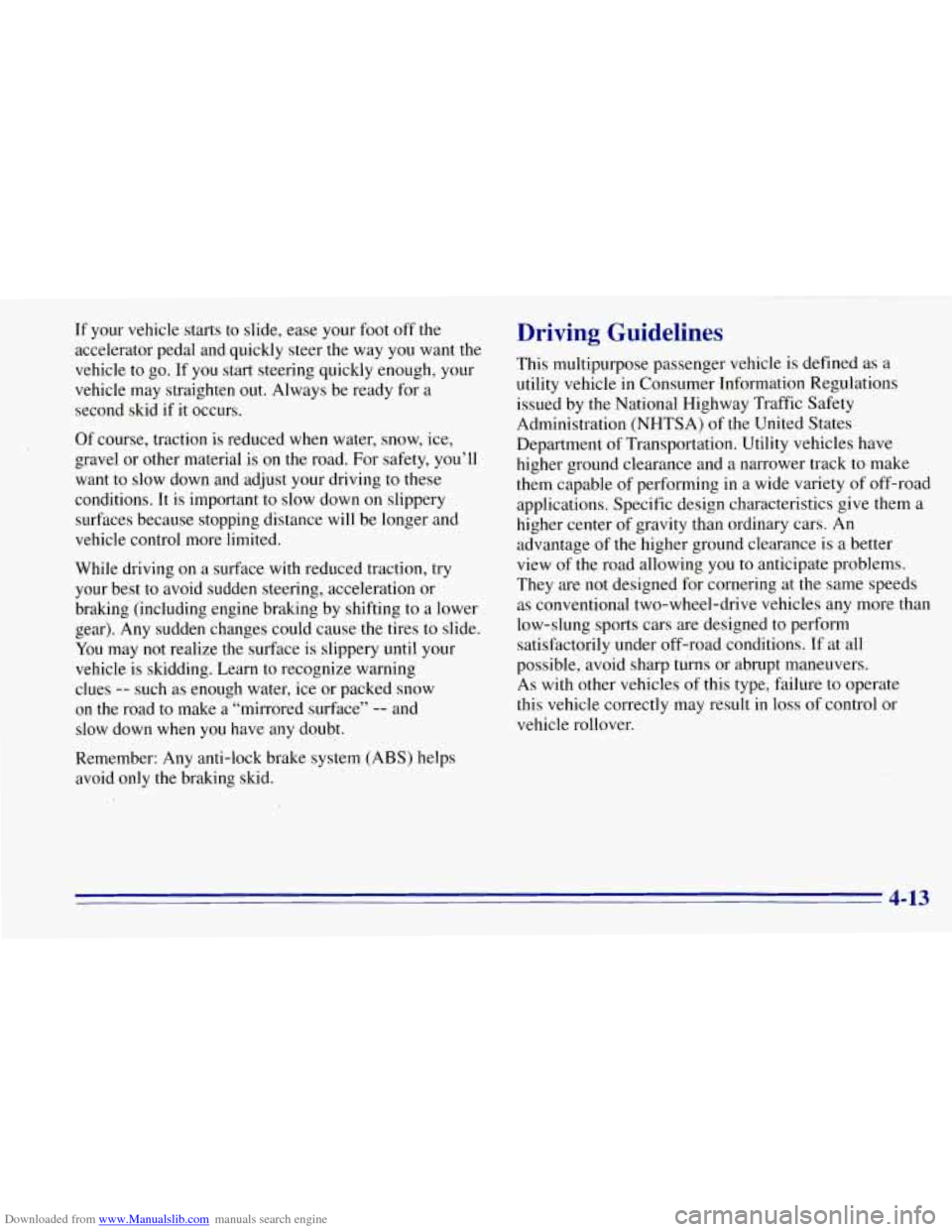
Downloaded from www.Manualslib.com manuals search engine If your vehicle starts to slide, ease your foot off the
accelerator pedal and quickly steer the way
you want the
vehicle to go. If you start steering quickly enough, your
vehicle may straighten out. Always be ready for a
second skid if
it occurs.
Of course, traction is reduced when water, snow, ice,
gravel or other material is on the road. For safety, you’ll
want to slow down and adjust your driving to these
conditions. It
is important to slow down on slippery
surfaces because stopping distance will be longer and
vehicle control more limited.
While driving on a surface with reduced traction, try
your best to avoid sudden steering, acceleration or
braking (including engine braking by shifting to a lower
gear). Any sudden changes could cause the tires to slide.
You may not realize the surface is slippery until your
vehicle is skidding. Learn to recognize warning
clues
-- such as enough water, ice or packed snow
on the road to make a “mirrored surface’’
-- and
slow down when you have any doubt.
Remember: Any anti-lock brake system (ABS) helps
avoid only the braking skid.
Driving Guidelines
This multipurpose passenger vehicle is defined as a
utility vehicle in Consumer Information Regulations
issued by the National Highway Traffic Safety
Administration
(NHTSA) of the United States
Department of Transportation. Utility vehicles have
higher ground clearance and a narrower track
to make
them capable
of performing in a wide variety of off-road
applications. Specific design characteristics give them a
higher center of gravity than ordinary cars. An
advantage of the higher ground clearance is a better
view of the road allowing you
to anticipate problems.
They are not designed for cornering at the same speeds
as conventional two-wheel-drive vehicles any more than
low-slung sports cars
are designed to perform
satisfactorily under off-road conditions. If at all
possible, avoid sharp turns or abrupt maneuvers.
As with other vehicles of this type, failure to operate
this vehicle correctly may result in loss
of control or
vehicle rollover.
4-13
Page 176 of 403
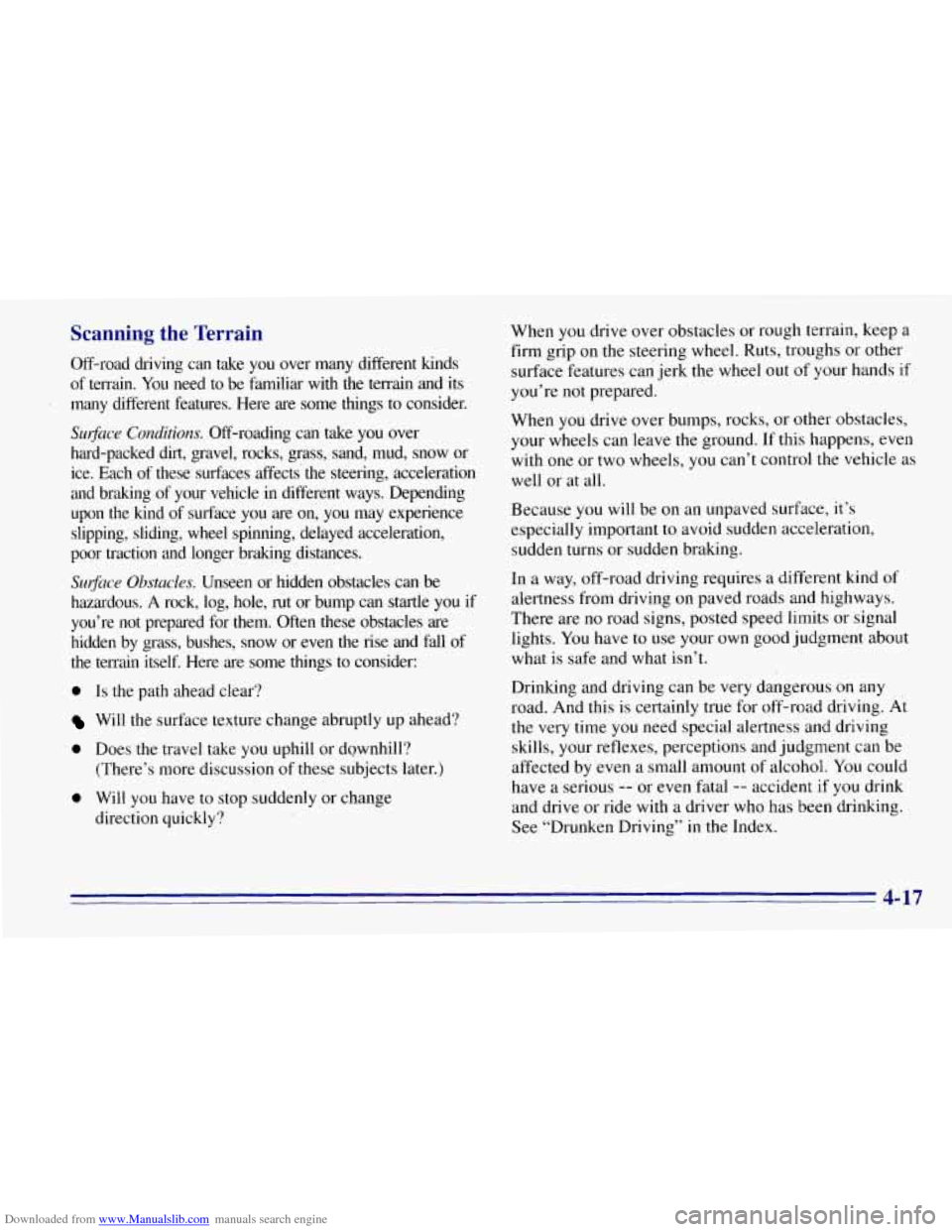
Downloaded from www.Manualslib.com manuals search engine Scanning the Terrain
Off-road driving can take you over many different kinds of terrain. You need to be familiar with
the terrain and its
many different features. Here are some things to consider.
Surfiuce Conditions. Off-roading can take you over
hard-packed
dirt, gravel, rocks, grass, sand, mud, snow or
ice. Each of these surfaces affectsthe steering, acceleration
and braking of your vehicle in different ways. Depending
upon the kind of surface
you are on, you may experience
slipping, sliding, wheel spinning, delayed acceleration,
poor traction and longer braking distances.
&$ace Obstacles. Unseen or hidden obstacles can be
hazardous.
-A rock, log, hole, rut or bump can startle you if
you’re not prepared for them. Often these obstacles are
hidden by grass, bushes, snow or even the rise and fall of
the terrain itself. Here are some things to consider:
0 Is the path ahead clear?
Will the surface texture change abruptly up ahead?
0 Does the travel take you uphill or downhill?
0 Will you have to stop suddenly or change
(There’s more
discussion
of these subjects later.)
direction quickly? When
you drive over obstacles or
rough terrain, keep a
firm grip on the steering wheel. Ruts, troughs or other
surface features can jerk the wheel out of your hands if
you’re not prepared.
When you drive over bumps, rocks, or other obstacles,
your wheels can leave the ground. If this happens, even
with
one or two wheels, you can’t control the vehicle as
well or at all.
Because
you will be on an unpaved surface, it’s
especially important to avoid sudden acceleration,
sudden turns or’ sudden braking.
In a way, off-road driving requires a different kind
of
alertness from driving on paved roads and highways.
There are no road signs, posted speed limits or signal
lights. You have
to use your own good judgment about
what is safe and what isn’t.
Drinking and driving can be very dangerous
on any
road. And this is certainly true for off-road driving. At
the very time
you need special alertness and driving
skills, your reflexes, perceptions and judgment can be
affected by even a small amount of alcohol.
You could
have a serious
-- or even fatal -- accident if you drink
and drive or ride with a driver who has been drinking.
See “Drunken Driving” in the Index.
4-17
Page 179 of 403

Downloaded from www.Manualslib.com manuals search engine e.” What should I do if my vehicle stalls, or is about
A: If this happens, there are some things you should
to stall, and I can’t make it up the hill?
do, and there are some things you must not do.
First, here’s what you
should do:
Push the brake pedal to stop the vehicle and
keep it from rolling backwards. Also, apply the
parking brake.
0 If your engine is still running, shift the transmission
to REVERSE (R), release the parking brake, and
slowly back down the hill in REVERSE (R).
restart it. With the brake pedal depressed and the
parking brake still applied, shift the transmission to
PARK
(P) and restart the engine. Then, shift to
REVERSE (R), release the parking brake, and’
slowly back down the hill as straight as possible in
REVERSE (R).
0 If your engine has stopped running, you’ll need to
0 As you are backing down the hill, put your left hand
on the steering wheel at the 12 o’clock‘position. This
way,
you’ll be able to tell if your wheels are straight
and maneuver as
you back down. It’s best that you
back down the hill with your wheels straight rather
than in the left
or right direction. Turning the wheel
too far
to the left or right will increase the possibility
of a rollover.
Here are some things you
must nut do if you stall, or are
about
to stall, when going up a hill.
0 Never attempt to prevent a stall by shifting into
NEUTRAL (N) to “rev-up” the engine and regain
forward momentum. This won’t work. Your vehicle
will roll backwards very quickly and you could
go
out of control.
Instead, apply
the regular brake to stop the
vehicle. Then apply the parking brake. Shift to
REVERSE (R), release the parking brake, and
slowly back straight down.
,e Never attempt to turn around if you are about to stall
when going up a hill. If the hill is steep enough to
stall your vehicle, it’s steep enough
to cause you to
roll over if you turn around. If you can’t make it up
the hill, you must back straight down the hill.
4-20
Page 181 of 403
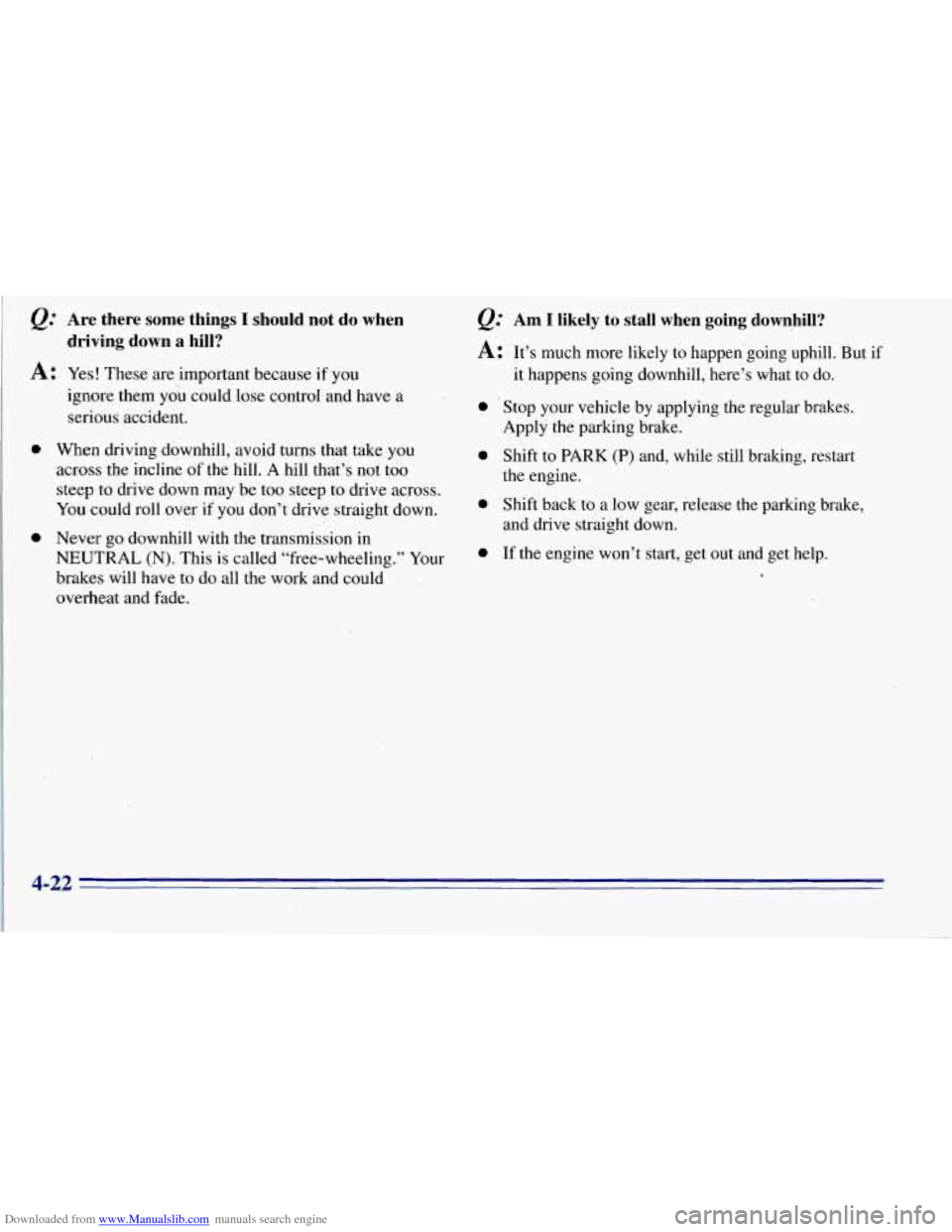
Downloaded from www.Manualslib.com manuals search engine Q: Are there some things I should not do when
driving down
a hill?
A: Yes! These are important because if you
0
0
ignore them you could lose control and have a
serious accident.
When driving downhill, avoid turns that take you
across the incline
of the hill. A hill that’s not too
steep
to drive down may be too steep to drive across.
You could roll over if you don’t drive straight down.
Never go downhill with the transmission in
NEUTRAL
(N). This is called “free-wheeling.” Your
brakes will have to do all the work and could
overheat and fade.
Q: Am I likely to stall when going downhill?
A: It’s much more likely to happen going uphill. But if
0
0
0
a
it happens going downhill, here’s what to do.
Stop your vehicle by applying the regular brakes.
Apply the parking brake.
Shift to PARK (P) and, while still braking, restart
the engine.
Shift back to a low gear, release
the parking brake,
and drive straight down.
If the engine won’t start, get
out and get help.
4-22
Page 183 of 403
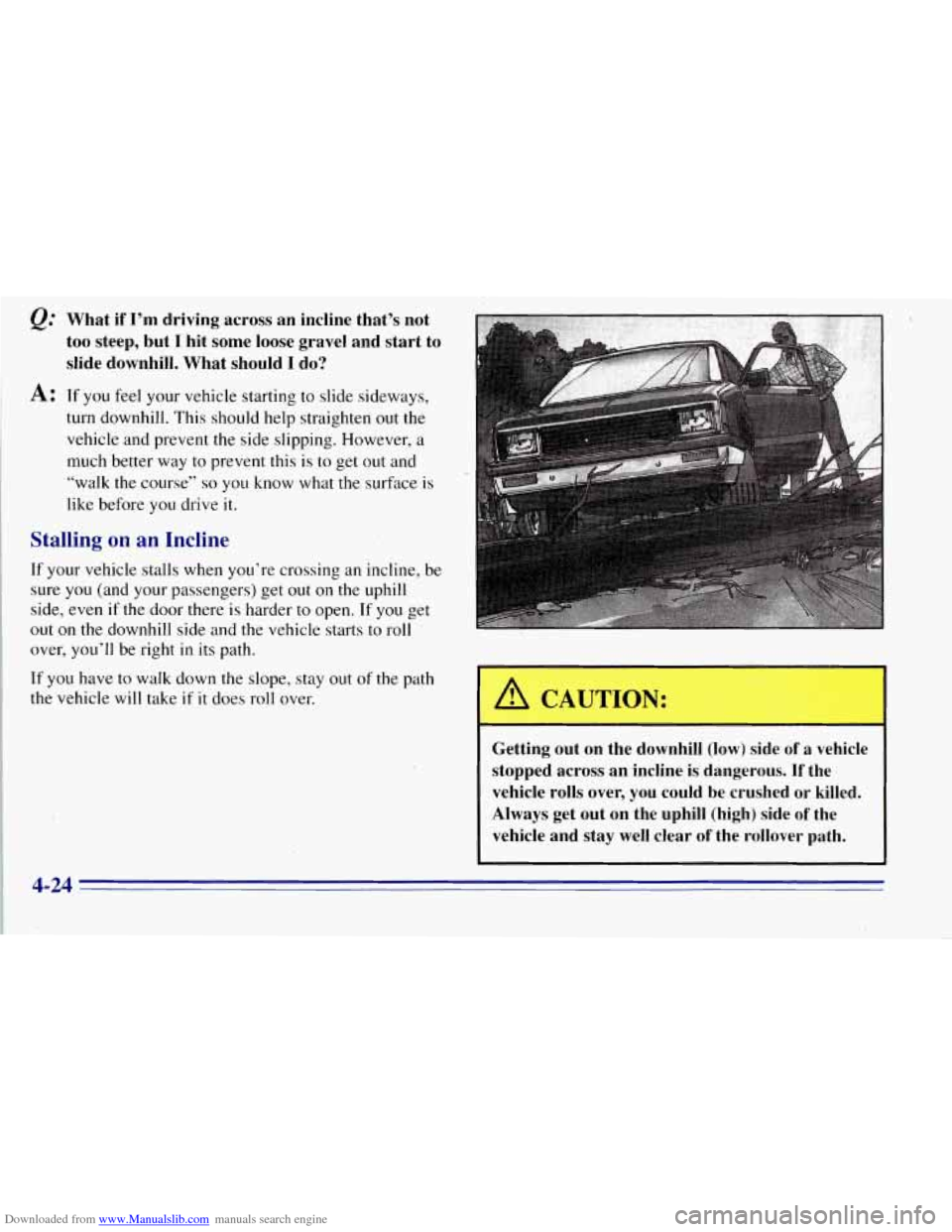
Downloaded from www.Manualslib.com manuals search engine turn downhill. This should help straighten out the
vehicle and prevent the side slipping. However, a
much better way to prevent this
is to get out and
“walk the course’’
so you know what the surface is
like before you drive it.
Stalling on an Incline
If your vehicle stalls when you’re crossing an incline, be
sure
you (and your passengers) get out on the uphill
side, even if the door there
is harder to open. If you get
out on the downhill side and the vehicle starts
to roll
over, you’ll be right
in its path.
If you have to walk down the slope, stay out of the path
the vehicle will take
if it does roll over.
Getting out on the downhill (low) side of a vehicle
stopped across an incline is dangerous.
If the
vehicle rolls over, you’could be crushed or killed.
Always get out on the uphill (high) side
of the
vehicle and stay well clear of the rollover path.
4-24